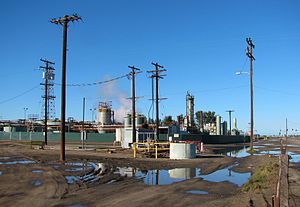Oxnard Oil Field
Most of the currently active oil wells are in the eastern portion of the field, west of the intersection of 5th Street and Pleasant Valley Road.
[3] The climate in the region is Mediterranean, with cool, rainy winters and warm, rainless summers, in which the heat is moderated by frequent morning coastal low clouds and fog.
It is mostly flat, with a very gentle slope to the south-southeast; drainage is along Revolon Slough to Calleguas Creek to Mugu Lagoon, and then to the Pacific Ocean.
Oil accumulations, of which there are many in the Ventura province, mainly occur in anticlinal settings modified by faulting; stratigraphy is also influential in creating traps for hydrocarbons.
Where the sedimentary rocks are sandstones with high porosity, and the structure and stratigraphy allow hydrocarbons to be trapped on their upward migration, oilfields are found.
[1] Only a tiny fraction of this has been brought to the surface to date, although Tri-Valley Corporation is actively developing the unit by drilling horizontal wells through the sands and subjecting them to the cyclic steam process.
According to Tri-Valley, some of the test wells have shown production rates of 1,000 barrels per day (160 m3/d), and can be brought online as soon as the steam generators and storage infrastructure are in place on the field.
[10] Between 1950 and 1981 Mandalay Bay was a permitted oil field waste disposal site which caused the release of numerous hazardous chemicals.
[11] The records of what was dumped were subsequently lost, resulting in calls for an investigation and millions of dollars in lawsuits from home buyers who were told the area was safe for habitation.
In 1998, Anadime Energy Services Inc. applied for permission from the county of Ventura to operate a commercial disposal site at 1933 E. Wooley Road near the Oxnard city limits.
They were unconvinced by the testimony that Ventura County, as the third-largest oil-producing region in the state, needs to allow brines to be disposed of effectively and cheaply.




